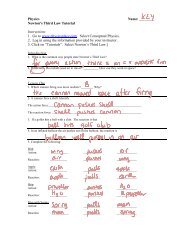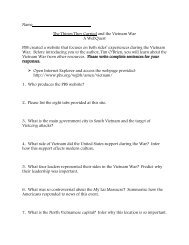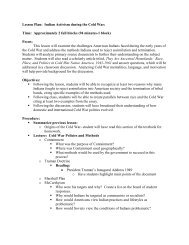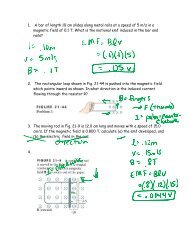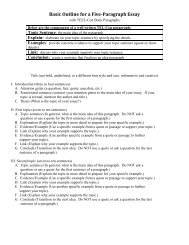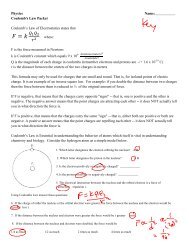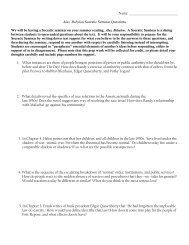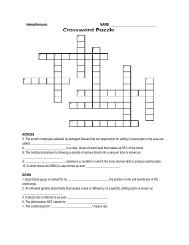Seely 1 Lesson Plan: The Red Summer: An Examination of Urban ...
Seely 1 Lesson Plan: The Red Summer: An Examination of Urban ...
Seely 1 Lesson Plan: The Red Summer: An Examination of Urban ...
You also want an ePaper? Increase the reach of your titles
YUMPU automatically turns print PDFs into web optimized ePapers that Google loves.
<strong>Seely</strong> 22<br />
*A Negro had been lynched and hanged from a “Loop” building overlooking<br />
Madison Street.<br />
*A white woman had been attacked and mutilated by a Negro on State Street.<br />
*A Negro woman had been slain, her breasts cut <strong>of</strong>f and her infant had been killed<br />
by having its brains dashed out against a wall.<br />
*A white child had been outraged by a colored man.<br />
*A white child bad been kidnapped by a band <strong>of</strong> colored men and its body later<br />
found, badly mutilated and dismembered.<br />
Immediately following the riots, a white woman was murdered in Evanston, III.<br />
Immediately the crime was laid at the door <strong>of</strong> a colored man with whom the woman had<br />
been intimate a number <strong>of</strong> years. Pitiful stories were told <strong>of</strong> the woman waiting for hours<br />
on street corners for “just one look at her Billiken-like, mulatto lover,” played up under<br />
headlines such as “CONFESSION EXPECTED TODAY FKOM NEGRO SUSPECT,”<br />
“NEGRO SUSPECT RAPIDLY WEAKENING” and the like which clearly led one to<br />
believe that the colored man was guilty. A few days later, in an obscure item on an inside<br />
page, a short account was given <strong>of</strong> the release <strong>of</strong> the colored suspect “because insufficient<br />
evidence to hold him” existed. A long period <strong>of</strong> such publicity had inflamed the minds <strong>of</strong><br />
many people against Negroes who otherwise would have been unprejudiced. Much <strong>of</strong> the<br />
blame for the riots can be laid to such sources.<br />
For a long period prior to the riots, organized gangs <strong>of</strong> white hoodlums had been<br />
perpetrating crimes against Negroes for which no arrests had been made. <strong>The</strong>se gangs in<br />
many instances masqueraded under the name <strong>of</strong> “Athletic and Social Clubs” and later<br />
direct connection was shown between them and incendiary fires started during the riots.<br />
Colored men, women and children had been beaten in the parks, most <strong>of</strong> them in Jackson<br />
and Lincoln Parks. In one case a young colored girl was beaten and thrown into a lagoon.<br />
In other cases Negroes were beaten so severely that they had to be taken to hospitals. All<br />
<strong>of</strong> these cases had caused many colored people to wonder if they could expect any<br />
protection whatever from the authorities. Particularly vicious in their attacks was an<br />
organization known locally as “Regan's Colts.”<br />
Much has been written and said concerning the housing situation in Chicago and its effect<br />
on the racial situation. <strong>The</strong> problem is a simple one. Since 1915 the colored population <strong>of</strong><br />
Chicago has more than doubled, increasing in four years from a little over 50,000 to what<br />
is now estimated to be between 125,000 and 150,000. Most <strong>of</strong> them lived in the area<br />
bounded by the railroad on the west, 30th Street on the north, 40th Street on the south and<br />
Ellis Avenue on cast. Already overcrowded this so called “Black Belt” could not possibly<br />
bold the doubled colored population. One cannot put ten gallons <strong>of</strong> water in a five-gallon<br />
pail. Although many Negroes had been living in “white” neighborhoods, the increased<br />
exodus from the old areas created an hysterical group <strong>of</strong> persons who formed “Property<br />
Owners' Associations” for the purpose <strong>of</strong> keeping intact white neighborhoods. Prominent<br />
among these was the Kenwood-Hyde Park Property Owners' Improvement Association,<br />
as well as the Park Manor Improvement Association. Early in June the writer, while in<br />
Chicago, attended a private meeting <strong>of</strong> the first named at the Kenwood Club House, at<br />
Lake Park Avenue and 47th Street. Various plans were discussed for keeping the Negroes



